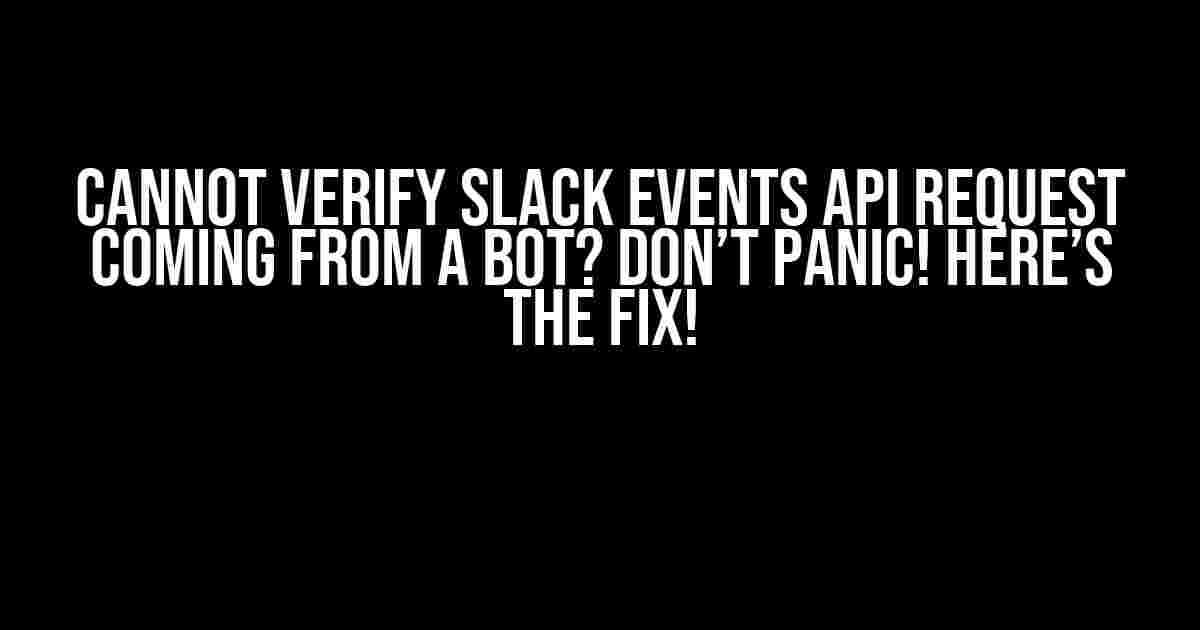Are you trying to integrate your Slack bot with the Events API, but getting stuck with the “Cannot Verify Slack Events API Request Coming from a Bot” error? Don’t worry, you’re not alone! This article is here to guide you through the troubleshooting process and get your bot up and running in no time.
What’s the Problem?
When you try to send an event to the Slack Events API, it’s expected to come from a verified source. This verification process involves checking the request’s signature to ensure it’s coming from a legitimate source. However, when the request comes from a bot, it can get tricky.
Why Does This Happen?
There are a few reasons why you might be getting this error:
Invalid Request Signature: The signature is invalid or tampered with during transmission.Invalid Bot Token: The bot token is incorrect, expired, or revoked.Server-Side Error: There’s a problem on Slack’s end, causing the verification to fail.
Troubleshooting Steps
Fear not! Let’s go through the troubleshooting process step-by-step:
-
Check the Request Signature
Make sure you’re generating the signature correctly. You can use a tool like
opensslor a library likejsonwebtokento create the signature.// Example using Node.js and jsonwebtoken const jwt = require('jsonwebtoken'); const signature = jwt.sign({ 'type': 'event_callback', 'token': 'your-bot-token', 'team_id': 'your-team-id', 'challenge': 'your-challenge', 'event': { 'type': 'event_type', 'data': 'event_data' } }, 'your-signing-secret'); -
Verify Your Bot Token
Double-check that your bot token is correct and hasn’t expired. You can do this by:
- Checking the Slack API documentation for your bot’s token.
- Using the Slack API to fetch your bot’s token and verify its validity.
-
Check Server-Side Errors
If the above steps don’t resolve the issue, it’s possible that there’s a problem on Slack’s end. Try:
- Contacting Slack support to check if there are any known issues.
- Retrying the request after a short delay to see if the error persists.
Additional Tips and Tricks
To avoid this error in the future, keep the following in mind:
| Tips | Description |
|---|---|
| Use a secure signing secret | Make sure your signing secret is strong and unique to prevent tampering. |
| Validate the request body | Verify the request body to ensure it’s not tampered with or malformed. |
| Use a reliable library or tool | Choose a reputable library or tool to handle the Events API integration to reduce the risk of errors. |
Conclusion
There you have it! By following these troubleshooting steps and tips, you should be able to resolve the “Cannot Verify Slack Events API Request Coming from a Bot” error. Remember to stay calm, methodically go through the process, and don’t hesitate to reach out to Slack support if needed. Happy bot-building!
Still stuck? Leave a comment below with your issue, and we’ll do our best to help you out!
Share this article with your fellow bot-builders to help them avoid this common pitfall. Happy coding!
Lastly, if you’re interested in learning more about Slack’s Events API and building awesome bots, check out our Ultimate Guide to Slack Bot Development. It’s packed with tutorials, examples, and best practices to get you started!
Frequently Asked Question
Having trouble verifying Slack events API requests coming from a bot? Don’t worry, we’ve got you covered! Here are some frequently asked questions to help you troubleshoot the issue:
What is the primary reason for the “Cannot Verify Slack Events API Request” error?
The primary reason for this error is usually an invalid or missing digital signature in the request. Slack uses digital signatures to verify the authenticity of events API requests. If the signature is invalid or missing, Slack will reject the request and return an error.
How do I generate a digital signature for my Slack events API request?
To generate a digital signature, you need to concatenate the request’s timestamp, the request body, and your signing secret in a specific format, then compute the HMAC-SHA256 hash of the resulting string. You can use libraries like OpenSSL or cryptography to generate the signature.
What should I do if I’ve generated the digital signature correctly but still get the error?
If you’ve generated the digital signature correctly, but still get the error, check if your request’s timestamp is within the allowed tolerance range (usually 5 minutes). Also, ensure that your signing secret is correct and matches the one configured in your Slack app.
Can I use a third-party library to handle Slack events API requests and signature generation?
Yes, you can use third-party libraries like Slack’s official SDKs or popular libraries like bolt-js or python-slack-sdk. These libraries handle signature generation and validation for you, making it easier to work with the Slack events API.
What are some common pitfalls to avoid when implementing Slack events API requests?
Some common pitfalls to avoid include using the wrong signing secret, incorrect timestamp formatting, and not handling errors and retries properly. Make sure to follow Slack’s official documentation and implementation guides to avoid these common mistakes.
